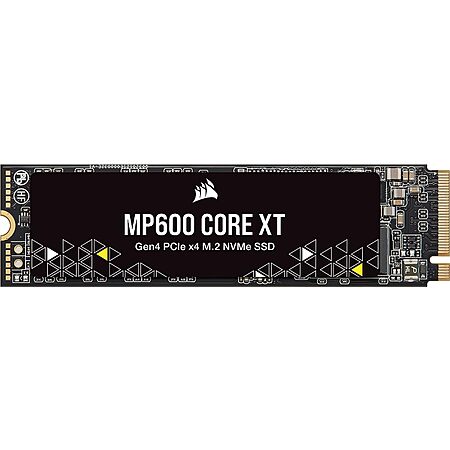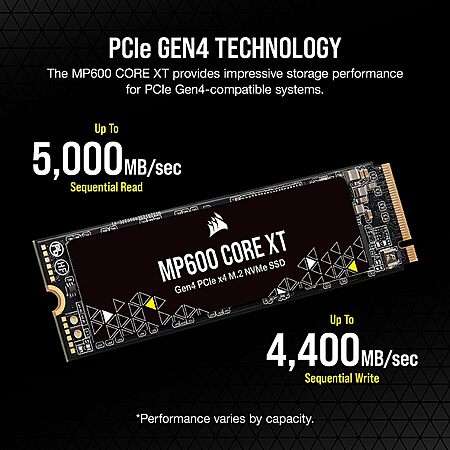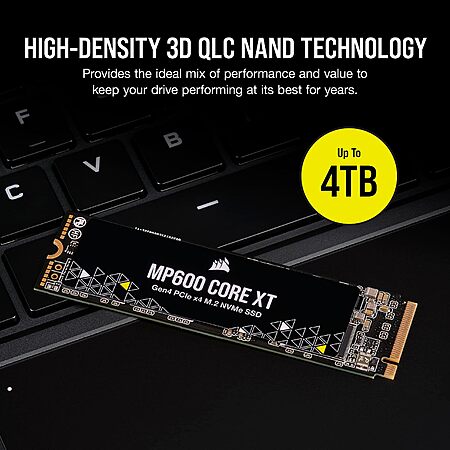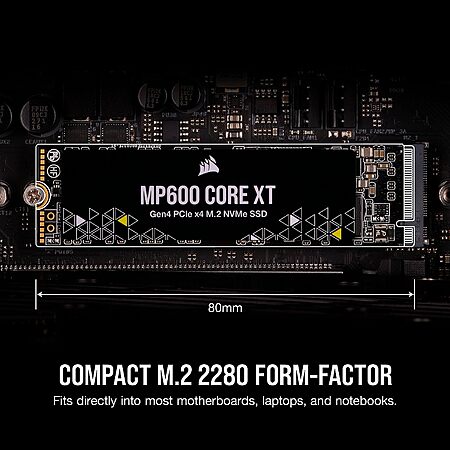expiredStrifeZero posted Sep 18, 2023 03:30 PM
Item 1 of 6
Item 1 of 6
expiredStrifeZero posted Sep 18, 2023 03:30 PM
2TB Corsair MP600 CORE XT PCIe 4.0 (Gen4) x4 NVMe M.2 Solid State Drive
& More + Free S/H$80
$175
54% offAmazon
Visit AmazonGood Deal
Bad Deal
Save
Share









Leave a Comment
Top Comments
Edit: Since there have been multiple people asking about what to use as a boot drive, I've gone into a fair amount of detail in this post further in this thread:
https://slickdeals.net/f/16930396-2tb-corsair-mp600-core-xt-pcie-4-0-gen4-x4-nvme-m-2-solid-state-drive-80-more-free-s-h?p=165900142#p
Dram (dynamic-random access memory) is essentially an additional flash memory chip in the ssd that functions similarly to the ram in your computer. Dram is able to store the data map tables instead of using the nand flash of the ssd, which allows for improved performance across the board, particularly random read and write performance for small files. This is far more meaningful to operating system performance compared to the heavily advertised peak sequential speeds of a ssd which are meaningless past a certain threshold in the vast majority of standard use. Additionally, by not requiring the data map tables to be stored and accessed from the nand flash, dram significantly reduces the wear on the ssd from standard use therefore increasing longevity and reliability. While hmb (host memory buffer) and to some extent slc/pslc caching can mitigate the downsides of using a dramless drive, unless the price difference is absolutely absurd I always recommend using a drive with dram for your boot drive which your operating system runs on.
Moving on to the type of nand flash used, tlc in general is simply a superior type of memory compared to qlc for most applications, with the primary downside being increased cost. Qlc memory tends to be slower (though higher density qlc used in higher capacity drives can close the gap somewhat) and has significantly worse endurance, especially in terms of writes. You will typically find qlc used in budget or value tier drives, and qlc drives with dram are significantly less common. Qlc drives due to their low cost tend to excel as cheap mass storage for those that don't wish to use hard drives.
The ssd controller is basically an embedded microcontroller functioning as the brains of the ssd, managing all the different functions. A high quality controller will allow for lower latency, faster performance, and better reliability. 4k random read and write performance (essentially the ability to quickly access, read, and write small files), which is the most important metric for operating system performance, is heavily affected by the controller. Most smaller ssd manufacturers will license a controller from a company such as phison, but some larger manufacturers (such as samsung, western digital, etc.) use their own in house controllers. When considering a drive for use as a boot drive it is best to pay attention to the random 4k random read and write performance (typically displayed in iops). Peak sequential read/write speed can be disregarded as long as it's over 5000 and your use case does not require constant copying of enormous (dozens of gigabytes) files.
Getting back to actual product recommendations, there unfortunately aren't any good value 4tb drives that are well suited for being boot drives (unless you count that one price mistake for the 4tb wd sn850x). The best options I know of are: the 4tb wd sn850x which occasionally goes on sale for $230, the 4tb teamgroup T-Force cardea a440 pro which is currently on sale for $220 on amazon, and the 4tb acer predator gm7000 which occasionally goes on sale for $200 (this uses the IG5236 controller which has been known to have issues, though firmware updates have supposedly fixed it).
If you're willing to use a 2tb drive as your boot drive rather than a 4tb drive there are tons of good options that provide a far better value. Some standouts include: the 2tb wd sn850x which has dropped as low as $90 and is regularly on sale for $100 with good additional cashback, the 2tb solidigm p44 pro (and the hynix platinum p41 which is the extremely similar previous version of this drive) which occasionally go on sale for $100, and the 2tb samsung 980 pro which is slightly slower but goes on sale for $90 or $100 with a built in heatsink and can rarely be found at a more substantial discount since it's been replaced by the 990 pro.
Ssd prices have been dropping for quite a while, and even though prices seem to have plateaued for now I'd expect there to be some good sales around black-friday/cyber-monday.
60 Comments
Sign up for a Slickdeals account to remove this ad.
And I agree the $90 sn850x was an insane deal (I bought one myself), but they were specifically asking about "decently priced" 4TB drives. It's possible their HW doesn't have another m.2 slot or enough PCIe lanes and a larger drive is the only upgrade path.
I would not recommend anyone purchase a 4tb drive for over $220 or so (and even that's really pushing it), but the unfortunate fact is that beneath $200 there are essentially no 4tb ssds that have good 4k random read and write performance. Hence, my recommendation in my previous posts to not consider a 4tb drive specifically for a boot drive until prices come down.
I would not recommend anyone purchase a 4tb drive for over $220 or so (and even that's really pushing it), but the unfortunate fact is that beneath $200 there are essentially no 4tb ssds that have good 4k random read and write performance. Hence, my recommendation in my previous posts to not consider a 4tb drive specifically for a boot drive until prices come down.
If you're willing to use a 2tb drive as your boot drive rather than a 4tb drive there are tons of good options that provide a far better value. Some standouts include: the 2tb wd sn850x which has dropped as low as $90 and is regularly on sale for $100 with good additional cashback, the 2tb solidigm p44 pro (and the hynix platinum p41 which is the extremely similar previous version of this drive) which occasionally go on sale for $100, and the 2tb samsung 980 pro which is slightly slower but goes on sale for $90 or $100 with a built in heatsink and can rarely be found at a more substantial discount since it's been replaced by the 990 pro.
Sign up for a Slickdeals account to remove this ad.
Edit: Since there have been multiple people asking about what to use as a boot drive, I've gone into a fair amount of detail in this post further in this thread:
https://slickdeals.net/f/16930396-2tb-corsair-mp600-core-xt-pcie-4-0-gen4-x4-nvme-m-2-solid-state-drive-80-more-free-s-h?p=165900142#p
https://www.westerndigi
https://www.westerndigital.com/pr...10BNC-WRSN [westerndigital.com]
As an additional note, 2tb is actually the current value sweet-spot, the best sales on 1tb drives tend to offer significantly worse price per terabyte compared to the best sales for 2tb drives.
https://www.newegg.com/intel-2tb-...eknUePgMUw
You are correct that DRAM is particularly beneficial when it comes to random I/O and that random I/O is going to be of far more significance to the average user than peak sequentials (which is what companies love to advertise). While a drive with DRAM (or at least HMB) is certainly preferable for an OS drive, I don't think it's as essential as some people say. Unless every second counts, even some DRAM-less SATA drives are adequate OS drives.
I'm not sure the pSLC cache is really pertinent to this discussion, as virtually all modern consumer drives have it in one form or another, regardless of if they have DRAM, HMB, or neither.
You are correct that DRAM is particularly beneficial when it comes to random I/O and that random I/O is going to be of far more significance to the average user than peak sequentials (which is what companies love to advertise). While a drive with DRAM (or at least HMB) is certainly preferable for an OS drive, I don't think it's as essential as some people say. Unless every second counts, even some DRAM-less SATA drives are adequate OS drives.
I'm not sure the pSLC cache is really pertinent to this discussion, as virtually all modern consumer drives have it in one form or another, regardless of if they have DRAM, HMB, or neither.
That drive is TLC, with a pSLC cache. There are no SLC (or even MLC) consumer drives anymore.
The pSLC is a write cache. Data is usually written there first, then transferred to MLC/TLC/QLC.
Thanks for the clarification
Dram (dynamic-random access memory) is essentially an additional flash memory chip in the ssd that functions similarly to the ram in your computer. Dram is able to store the data map tables instead of using the nand flash of the ssd, which allows for improved performance across the board, particularly random read and write performance for small files. This is far more meaningful to operating system performance compared to the heavily advertised peak sequential speeds of a ssd which are meaningless past a certain threshold in the vast majority of standard use. Additionally, by not requiring the data map tables to be stored and accessed from the nand flash, dram significantly reduces the wear on the ssd from standard use therefore increasing longevity and reliability. While hmb (host memory buffer) and to some extent slc/pslc caching can mitigate the downsides of using a dramless drive, unless the price difference is absolutely absurd I always recommend using a drive with dram for your boot drive which your operating system runs on.
Moving on to the type of nand flash used, tlc in general is simply a superior type of memory compared to qlc for most applications, with the primary downside being increased cost. Qlc memory tends to be slower (though higher density qlc used in higher capacity drives can close the gap somewhat) and has significantly worse endurance, especially in terms of writes. You will typically find qlc used in budget or value tier drives, and qlc drives with dram are significantly less common. Qlc drives due to their low cost tend to excel as cheap mass storage for those that don't wish to use hard drives.
The ssd controller is basically an embedded microcontroller functioning as the brains of the ssd, managing all the different functions. A high quality controller will allow for lower latency, faster performance, and better reliability. 4k random read and write performance (essentially the ability to quickly access, read, and write small files), which is the most important metric for operating system performance, is heavily affected by the controller. Most smaller ssd manufacturers will license a controller from a company such as phison, but some larger manufacturers (such as samsung, western digital, etc.) use their own in house controllers. When considering a drive for use as a boot drive it is best to pay attention to the random 4k random read and write performance (typically displayed in iops). Peak sequential read/write speed can be disregarded as long as it's over 5000 and your use case does not require constant copying of enormous (dozens of gigabytes) files.
Getting back to actual product recommendations, there unfortunately aren't any good value 4tb drives that are well suited for being boot drives (unless you count that one price mistake for the 4tb wd sn850x). The best options I know of are: the 4tb wd sn850x which occasionally goes on sale for $230, the 4tb teamgroup T-Force cardea a440 pro which is currently on sale for $220 on amazon, and the 4tb acer predator gm7000 which occasionally goes on sale for $200 (this uses the IG5236 controller which has been known to have issues, though firmware updates have supposedly fixed it).
If you're willing to use a 2tb drive as your boot drive rather than a 4tb drive there are tons of good options that provide a far better value. Some standouts include: the 2tb wd sn850x which has dropped as low as $90 and is regularly on sale for $100 with good additional cashback, the 2tb solidigm p44 pro (and the hynix platinum p41 which is the extremely similar previous version of this drive) which occasionally go on sale for $100, and the 2tb samsung 980 pro which is slightly slower but goes on sale for $90 or $100 with a built in heatsink and can rarely be found at a more substantial discount since it's been replaced by the 990 pro.
Ssd prices have been dropping for quite a while, and even though prices seem to have plateaued for now I'd expect there to be some good sales around black-friday/cyber-monday.
Sign up for a Slickdeals account to remove this ad.
I bet I know why the 4 TB is backordered
I found it extremely suspicious that corsairs PayPal address, Is disputes and chargebacks at Zendesk
I suspect they got the same bad batch of chips from Malaysia that Sandisk western digital did
I guess I'll reach out to the reporter who wrote that article that he is never gonna deal with Sandisk ever again because of the way they handled the return
I think I'll tell him to be a little more sympathetic the Malaysian supplier sent everyone millions of bad chips without checking them
That might be OK at Harbor freight but that does not work for solid State drives.
I wonder how much the supply chain apocalypse is contributing
remember when that ship got stuck well now there's a drought there, so the Panama Canal is broken
I'm going to tell that reporter at least Sandisk WD is returning the disks and acknowledging the problem that they got 1 million defective chips while Corsair is pretending that didn't even happen
If you have 1 million people trying to return a product at the same time then you're gonna have a problem but at least Sandisk acknowledges the problem where corsair doesn't even answer me they don't answer the phone they don't answer email so I filed a dispute and I wouldn't even use this as Any kind of storage device I guess it's USB 1.0
Your PlayStation is not broken. Your computer is not broken. It's the SSD must be the controller.
I guess I'll keep it. If they don't wanna send me a label after I get my money back, I can export to it.
8MB a sec for QuickTime encoding
It still reads very quickly.
I mean they ask for things that they already know if they have my order number then they know what I bought and they shouldn't be asking me to repeat those details and send them serial numbers they have my order all they need is the order number to know the problem that it's broken Defective and I want a return label they should just send me a return label and not ask me for any details
In fact, that's all they need. I replied to their delivery confirmation with the order number and I said this is defective and they should've just replied with the label and I think it's been like a week of getting automated messages and nothing but a runaround.
The only thing that could possibly explain a company with a good reputation behaving This way is if they have 1 million returns at the same time.
A few people are going to put this into a device and not know what is the problem because it works so slowly you might not identify the problem as a one chip on this SSD
It behaves as if it has a 20 GB cache instead of 333
But then to drop down to 30 MB a second, that's only a third of the crucial I was complaining about with a 256 cache then 90MBs
I just bought the 4 TB version of this drive directly from Corsair based on a post I saw here and it works great for 20 GB and then it drops down to 30 MB a second. so for me to save that video file that's like overnight for a 250 GB movie
Leave a Comment